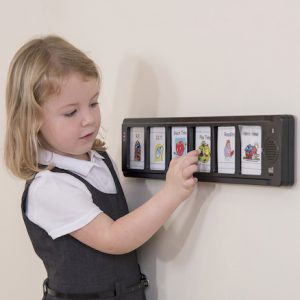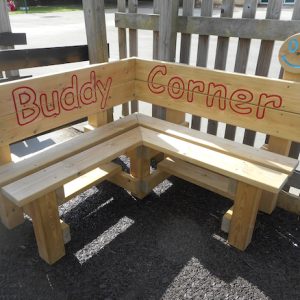-
Take care of ourselves
This is at the top of the list for a reason! Teaching can be stressful at times. We can only be supportive teachers to our pupils if we are fully rested and feeling healthy, both physically and mentally. Ensure that you spend time with friends and family and focus on hobbies and interests. If you feel yourself struggling with your mental health, be sure to seek support.
-
Foster good relationships with your pupils
Forming good relationships with your pupils is integral to creating a relaxed and trusting environment where pupils feel comfortable sharing their worries. A teacher who understands their pupils’ strengths and weaknesses, and their culture, life and individual learning needs can foster confidence in their pupils, which can lead to a positive and successful learning experience.
In talking about our feelings regarding challenges and successes, we become positive role models for our pupils. Through interactions with members of staff, we can also demonstrate how to be caring and respectful towards others.
-
Form positive connections with parents
Having effective communication with parents is crucial in creating a positive learning space for pupils. When teachers are well-informed about issues in their pupils’ home lives and additional needs, they can ensure they provide extra or tailored support when necessary.
Children with additional needs may need support with assistive devices such as hearing aids or wheelchairs. If you are aware that a new pupil will be joining your class who has additional needs, ensure that you speak to their parents before the child enters the class. This means you can check the accessibility of the classroom and make any necessary accommodations. You can also learn about necessary assistive devices and help to limit any potential distress during the child’s transition into your classroom.
-
Have regular check-ins with your class
Personal, Social, Health and Citizenship Education (PSHCE) sessions or Circle Times are a good opportunity for a general catch-up. These sessions can also have a particular focus on a relevant theme, such as friendship or health. To optimise inclusivity, some children may need support in staying engaged during Circle Time and a fidget toy may be helpful.
Ensure the topic is relevant to the class, so that children are more likely to pay attention. Try to address all learning styles in your approach, including plenty of visual and verbal information.
Circle time or class check-in after break times may be necessary to address any conflicts. As a class, you can discuss appropriate ways of dealing with these. Once any disputes have been settled, children will have more focus to apply to their learning.
-
Keep moving
We are told as adults that going outside and moving can help lower stress and improve mood. This also applies to children. Is there a free slot on the playtime schedule? Even just 5 or 10 minutes of movement, breathing some fresh air and enjoying some natural light can be beneficial. If you cannot get outside or do not have the time, consider breaking up classroom activities with a quick dance or movement activity to stimulate the brain!
-
Relax
Setting aside time for pupils to practise yoga, meditation, or engage in a relaxing activity such as colouring, playdough play, or drawing, can give pupils some time out of the busy day to recharge. Some children may find it easier to relax while carrying out an activity, and others may find meditation beneficial. You can also use this time to invite pupils to come and speak to you in case they have something to share.
-
Play music
Did you know that listening to music can reduce heart rate, lower blood pressure, decrease stress and elevate mood? – Research shows that classical music can aid focus.
When playing music in the classroom, the most crucial factor is how your pupils respond to it. It might take a bit of trial and error before finding a suitable selection. In the case of children with sound sensitivities, ensure they are happy with the volume levels and the tone of the music. Take time to ask your pupils what they enjoy and carry out observations to see which type of music seems most beneficial.
-
Create a class worry box
Children (and the teacher) can write or draw their worries on a piece of paper and put them in a designated Worry Box. The Worries can be anonymous or named. You can discuss the contents of the worry box (as a class or with individuals) each week at a scheduled time so that children know their worries will be addressed.
-
Establish routines and structure
Children with additional needs, particularly those with autism spectrum disorder, may prefer repetition and having a clear schedule. Children with hearing issues or visual learners can benefit from the visual representation of the different elements of the school day. Why not create a visual timetable using a Recordable Talking Panel to ensure ease of access for auditory learners too.
Creating structure using tools such as a visual timetable. Ensuring that activities are scheduled at the same time each week, when possible, can help your pupils feel confident within the classroom routine.
-
Encourage friendships
Loneliness has an enormous impact on mental health. A buddy system helps to promote friendship and can facilitate a greater sense of community in the school. Children in each year group are elected as, or apply to be, a Buddy. Buddies wear something such as a sash, bib, or sticker so that they can be easily identified. Their job is to help children resolve small conflicts during break times and to support any child who is feeling lonely, helping them to make friends.
A Buddy Bench can also provide the opportunity for children to make new friends.
-
Celebrate Differences
We are all different and we all have our individual needs. We can support pupils by teaching them how to include and respect each other and to recognise their strengths and differences. These differences deserve to be celebrated!
Taking care of our pupils’ mental health works best when there is a whole-school environment, which emphasises inclusion and cooperation. If this is something that you feel needs to be addressed in your educational setting, consider speaking to a member of the senior management to discuss a whole-school approach.
Every child is unique, and everyone has individual learning and emotional needs. It might involve some trial and error, but by working together, teachers, parents and schools can ensure that all children are well supported in their mental health and wellbeing.
With many thanks to Carly Sygrove for writing this blog.
Carly is a hearing health advocate who has single-sided deafness. With 14 years of experience working as an Early Years teacher in schools in the UK, Spain, China and Thailand, her professional background is deeply rooted in Education.
In 2016, she experienced a sudden hearing loss in her left ear, which impacted her career, teaching her some valuable lessons about accessibility and inclusion.
She writes about living with hearing loss at My Hearing Loss Story and manages an online support group for people with hearing loss. She is also the founder of the Sudden Hearing Loss Support website, a source of information and support for people affected by sudden hearing loss.












